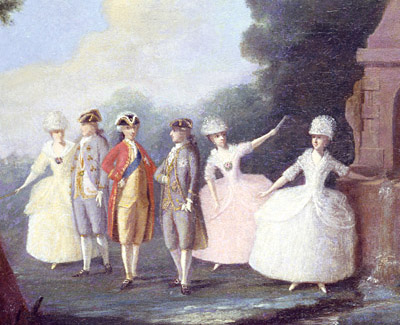| De kongelige

| | Afslutningen på de mange krige imellem Danmark og Sverige og Skånelandenes definitive overgang til Sverige gjorde det vanskeligere at passere Øresund. Der krævedes nu pas for at passere Øresund og samkvem over Sundet, hvilket, i nogen grad, begrænsede de tætte kontakter.
Giftermål imellem kongefamilierne gav impulser til forbedring, men under Napoleonskrigene havner de to lande på hver sin side i konflikten og Norges overgang til forbund med Sverige i 1814 kølner forholdet igen. |
Neutralitetsforbund i 1756
I Danmark er holdningen til Sverige i årtierne efter Store nordiske Krigs afslutning 1720 forholdsvis forsonlig. Danmark har efterhånden endegyldigt affundet sig med at Skånelandene var tabt, mens det i Sverige måske kniber mere med at se den nyligt tabte stormagtsstatus i øjnene.
Begge parter er tidligt opmærksom på de russiske stormagtsambitioner i Østersøområdet og i 1740erne taler den danske embedsmand Schulin om at ”de tre nordiske riger vilde vinde i magt og selvstændighed og lykke” ved en forening. Bestræbelser på at skabe en nordisk personalunion med udgangspunkt i en dansk kronprins midt i århundredet lykkes ikke, men i 1756 sluttes et neutralitetsforbund imellem de to stater.
Skandinavisk kongebryllup
I 1766 ægter den svenske konge Gustav 3. den danske prinsesse Sofie Magdalene. Gustav gæster i 1770 som kronprins Danmark og som svensk regent aflagde han et kort besøg i 1786. Man modtog d. 9.juli kong Gustav på Marienlyst Slot ved Helsingør, hvortil kongen var ankommet klokken 12. Der blev dineret med ledsagelse af tyrkisk kammermusik ved Livgardens oboister og tilkaldte ditto fra Kronborg. Kl. 18 begav man sig til Hellebæk for at bese geværfabrikken og ud på aftenen returnerede den svenske konge så efter dette korte venskabsbesøg.

Gustav 3. på Fredensborg |
Uanmeldt besøg
Kong Gustav vendte tilbage i oktober måned 1787, denne gang på uanmeldt besøg. I den anledning beskrev Tidskriftet ”Minerva”, hvilken stor glæde enhver ”Skandinav” måtte føle ved det fællesskab, som dette besøg fremviste. Således gik det til at ordet Skandinav blev et begreb.
Ret beset var danskerne dog bekymrede ved det sidste besøg, som kom helt bag på hofetiketten og fordi man frygtede for skjulte udenrigspolitiske dagsordener. Allerede under det første besøg havde den danske konge spyttet i suppen og umotiveret forladt måltidet, så man frygtede, hvad den enevældige, men sindsforvirrede kong Christian VII kunne finde på, eller blive lokket til. Gustav havde planer om udvidelser mod øst, men Danmark havde en alliance med Rusland og i 1788 kommer de to parter som følge af alliancen på kant med hinanden.
Gustav 3. myrdes
I 1792 bliver den svenske konge imidlertid myrdet under et maskebal på Stockholms Slot og krigsfaren driver over for denne gang. Samme år holdt den danske professor Sneedorff et foredrag i Det nordiske Selskab i London, om hvor vigtigt det var at de tre nordiske lande forenedes og i 1794 underskrives endnu et væbnet neutralitetsforbund imellem Danmark og Sverige og i den anledning udtaler den danske udenrigsminister Bernsdorff at ”Alt hvad der nærmer Sverige og Danmark til hinanden er naturligt; alt hvad der skiller dem er uretfærdigt og unaturligt”.
Svenskere i dansk eksil
En af de implicerede i mordet på Gustav 3. grev Claes Horn måtte tilbringe sine dage i dansk eksil og ligger begravet på Assistens Kirkegård i København. Den landflygtiges vilkår har ofte været kummerlige og man har været henvist til andres nåde. En Notits skrevet af Grev Horn, formodentlig tiltænkt den danske konge og fundet i en vase på Marienlyst Slot af embedsmanden, geheimeråd Johan Bülow vidner om hans tilstand:
”Ophøjede ejer af disse steder, Deres Folks kærlighed! Forsmå ikke en flygtnings oprigtige hyldest, en flygtning som fra fjerne kyster beskuer sit eget hjemland, idet han jamrer over sin skæbne og alle andre nationers som regeres af konger som ikke ved hvordan de skal efterligne Dem.”
Deltagelse i et mordkomplot er ifølge sagens natur en alvorlig sag, men både Claes Horn og adelsmanden Ehrensvärd tåles og trives i Danmark og tilsyneladende har det ikke slået alvorlige skår i det dansk- svenske forhold i tiden omkring århundredeskiftet.
Napoleonskrigene
På trods af neutralitetsforbundet havnede Sverige og Danmark under Napoleonskrigene atter på hver sin side i den europæiske storkonflikt og det kommer sågar til enkelte mindre sammenstød imellem de to parter i 1808-09 og senest i 1813. Efter avsättningen av den svenske konge Gustav IV Adolf, vælges en dansk prins Christian August til tronfølger, men efter hans bratte død indsættes en tidligere fransk general, Bernadotte på tronen. Bernadotte konverterer til den protestantiske tro på det svenske konsulat i Helsingør og sætter herefter over Sundet.
Resultatet af napoleonskrigene bliver i korte træk at Sverige mister Finland til Rusland i 1809 og Danmark Norge, som i stedet forenedes med Sverige i 1814. Norges overgang til Sverige medfører en nedkøling af det indbyrdes forhold, men i løbet af nogle årtier øges kontakten atter betydeligt bl.a. som følge af en udbedring af samfærdselsmidlerne.

Mindesmærke for Christian August | 
Svenske konsulat i Helsingør | 
Det svenske konsulat i Helsingør | 
Bernadotte i Helsingborg | 
Bernadottemonumentet i Helsingborg |
|